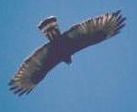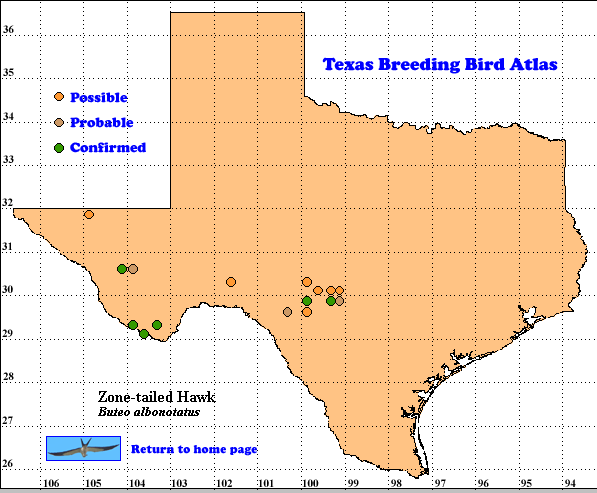Zone-tailed Hawks are sometimes seen soaring with Turkey Vultures (Coragyps atratus), but more often hunt like Northern Harriers (Circus cyaneus), flying low over fields in search of prey such as chipmunks, ground squirrels, lizards and small birds. Amphibians, another frequent prey item, are presumably captured in riparian area where fish are also caught. Zone-tailed Hawks can be confused with Common Black-Hawks (Buteogallus anthracinus) which also nest and forage in riparian areas (Johnson et al. 2000).
DISTRIBUTION. During the 1987-1992 field work seasons of the TBBA project, volunteers found breeding evidence for Zone-tailed Hawks in the Trans-Pecos and Edwards Plateau regions (see the region map in Lockwood and Freeman [2004]). In the Trans-Pecos atlasers found a possible site in latilong-quad 31104-H7 (the Guadalupe Mountains) and a confirmed, a probable and a possible in 30104 and a confirmed and a probable in 30103, both in the Davis Mountains. Three confirmed sites were found in 29103 in the Big Bend National Park area, and 2 possibles were located on or near the Pecos River in 30101. Finally in the Edwards Plateau area, 2 confirmed, 2 probable and 6 possible sites were found in latilongs 29099, 29100 and 30099.
Zone-tailed Hawks are also summer residents in Arizona, New Mexico and the highlands of northern Baja California and northern mainland Mexico, moving south or to lower elevations in winter. From here south, the situation in Middle America is less clear. Although there are winter records in many areas, breeding has only been reported in northwest Costa Rica (Stiles and Skutch 1989, Howell and Webb 1995, Johnson et al. 2000). This species is resident in north and central South America (excluding Amazonia), south to southern Brazil. Bolivia, Paraguay and Ecuador (An, Ornithol. Union 1998).
SEASONAL OCCURRENCE. In spring Zone-tailed Hawks arrive in Texas between mid-March and mid-May with most individuals coming from late March to late April. Breeding occurs from March to July, based on egg dates from March 29 to June 2. These hawks move south between early September and late October. (Oberholser 1974). In Arizona, atlasers found breeding evidence from April through July (Corman 2005).
BREEDING HABITAT. Zone-tailed Hawks breed in Texas in the Davis Mountains between 1750 and 1950 m (5800-6450 ft) on remote, steep, north-facing slopes in open stands of 20-40 m (65-130 ft) ponderosa pines. In the Chisos Mountains nests were located at 2000 m (6600 ft) in dense oak-juniper habitat and along the Rio Grande River these hawks nested on cliffs averaging 65 m (215 ft) high, with flora dominated by creosote bush, honey mesquite, ocotillo and lechuguilla (Matteson and Riley 1981). In Arizona atlasers found this species breeding in riparian habitats (57%) and montane forests (27%; Corman 2005).
Nests in montane areas, built by both mates, are placed in a main crouch at or near the top of a ponderosa pine or oak tree and are composed of oak and pine sticks, 25-46 cm (10-18 in) long. The inner cup is lined with fresh moss, juniper bark, oak leaves and pine needles. Nests are often reused in successive years. In the nest cup the female usually lays 2 white or bluish white eggs, unmarked or faintly spotted, distinguishing them from the heavily marked eggs of the Common Black-Hawk. The female incubates the eggs for 28-34 days and the young fledge from about 41-52 days after hatching (Harrison 1979. Johnson et al. 2000).
STATUS. Zone-tailed Hawks are uncommon and local summer residents in their limited breeding range in Texas (Lockwood and Freeman 2004). The breeding range appears to have contracted in the past, since the map of historic breeding and summer records in Oberholser (1974) shows more records on and around the Edwards Plateau and in Cameron County in south Texas than the TBBA map does. This state lists Zone-tailed Hawk as a Threatened species, the only conservation listing this hawk has had in the United States ( Johnson et al. 2000). Threatened is certainly an appropriate characterization of the status of this hawk in Texas.
Text by Robert C. Tweit (2007)
Literature cited.
American Ornithologists’ Union. 1998. Checklist of North American birds, 7thed. Am, Ornithol. Union, Washington, DC.Corman, T. E. 2005. Zone-tailed Hawk (Buteo albonotatus). In Arizona Breeding Bird Atlas. pp. 144-145 (T. E. Corman and C. Wise-Gervais, eds.), University of New Mexico Press, Albuquerque.
Harrison, H. H. 1979. A field guide to western birds’ nests. Houghton Mifflin, Boston, MA.
Howell, S. N. G. and S. Webb. 1995. A guide to the birds of Mexico and northern Central America. Oxford University Press, New York.
Johnson, R. R., R. L. Glinski and S. W. Matteson. 2000. Zone-tailed Hawk (Buteo albonotatus). InThe Birds of North America, No. 529 (A. Poole and F. Gill, eds.). The Birds of North America, Inc., Philadelphia, PA.
Lockwood, M. W. and B. Freeman. 2004. The TOS handbook of Texas birds. Texas A&M University Press, College Station.
Matteson, S. W, and J. O. Riley. 1981. Distribution and nesting success of Zone-tailed Hawks in west Texas. Wilson Bull. 93: 282-284.
Oberholser, H. C. 1974. The bird life of Texas, University of Texas Press, Austin.Stiles, F. G. and A. F. Skutch. 1989, A guide to the birds of Costa Rica. Cornell University Press, Ithaca, N. Y.

